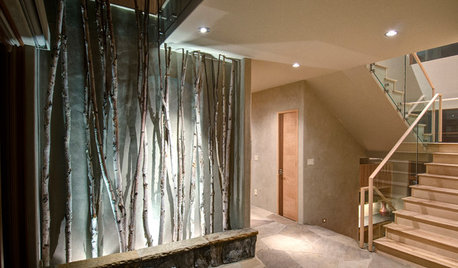Branch kinda splitting off trunk (oak tree)
lou_spicewood_tx
17 years ago
Related Stories

DECORATING GUIDESBring Nature Indoors With Tree Stumps, Trunks and Logs
Furniture formed from wood in its natural state adds earthy elegance to any room
Full Story
GARDENING GUIDESGreat Design Plant: Parkinsonia Florida
Blue palo verde's trunk and branches provide a beautiful backdrop to a spectacular spring show in the desert
Full Story
DECORATING GUIDESBranches and Twigs for More Than Just Decor
Think beyond the vase with twigged-out railings, gates, room dividers and more
Full Story
TREESHow to Use Trees Inside
Bring nature close by integrating the beauty of trunks and trees — even smaller leafy trees — into your home
Full Story
GARDENING GUIDESTree Care: Common Tree Diseases and What to Do About Them
Learn to recognize trees that may be affected by diseases or pests so you can quickly take action
Full Story
FALL GARDENING6 Trees You'll Fall For
Don’t put down that spade! Autumn is the perfect time for planting these trees
Full Story
GREEN BUILDINGHouzz Tour: Going Completely Off the Grid in Nova Scotia
Powered by sunshine and built with salvaged materials, this Canadian home is an experiment for green building practices
Full Story
MOST POPULARHouzz Tour: Going Off the Grid in 140 Square Feet
WIth $40,000 and a vision of living more simply, a California designer builds her ‘forever’ home — a tiny house on wheels
Full Story
LANDSCAPE DESIGN7 Great Trees for Summer Shade and Fall Color
These landscape-pro faves straddle the seasons beautifully. Could one enhance your own yard?
Full Story
HOLIDAYSChristmas Tree Decorating the Painless Way
Holidays are for carols, not cussing. Make tree trimming less work and more fun with this guide at your side
Full Story




spruceman
lou_spicewood_txOriginal Author
Related Discussions
Oak Tree split - What to do?
Q
Panic time! Why did this branch fall off my huge oak?
Q
Three main branches twisting together on top of oak tree - CUT??
Q
Removing secondary oak tree trunk at base
Q
lou_spicewood_txOriginal Author
pineresin
ken_adrian Adrian MI cold Z5
krazyaroider
spruceman
lou_spicewood_txOriginal Author
ronalawn82
lou_spicewood_txOriginal Author
pineresin
ken_adrian Adrian MI cold Z5
lou_spicewood_txOriginal Author
spruceman
lou_spicewood_txOriginal Author
pineresin
katrina1
lou_spicewood_txOriginal Author
spruceman
alabamatreehugger 8b SW Alabama
pineresin
krazyaroider
lou_spicewood_txOriginal Author
ken_adrian Adrian MI cold Z5
lou_spicewood_txOriginal Author
spruceman